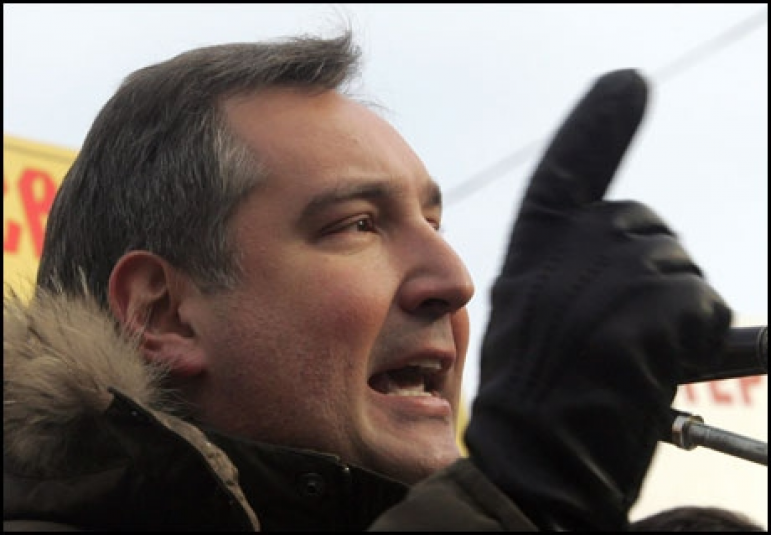
The Arctic Template of Russian National Security Policy
Publication: Eurasia Daily Monitor Volume: 11 Issue: 59
By:

Ukraine shows that Russia’s threat assessments are cynical, mendacious, inclined toward worst-case scenarios, self-aggrandizing and self-reinforcing. They betray not just an incipient trend toward paranoia, but also hysteria about foreign threats and a tendency toward grandiosity. Recent developments in Russia’s Arctic policy show that this is as true for Moscow’s thinking on the Far North as it is on Ukraine. Since long before the occupation and annexation of Crimea, Vladimir Putin and the Russian government have argued that military threats to Russia are incessantly growing. And these same assessments have also been justifying Russia’s ongoing military activities in the Arctic (see EDM, September 23, December 16, 2013).
Now Deputy Prime Minister Dmitry Rogozin claims that Moscow cannot rule out the possibility of covert foreign attempts to force Russian mining projects out of the Arctic region on the basis of claims of noncompliance with ecological standards (Interfax, March 14). Since Moscow has frequently used this ploy against foreign energy companies (see EDM, January 24, 2012), it is not surprising that Rogozin invoked it. But he makes no effort to explain who would try to use this strategy against Russian enterprises on Russian territory. Rogozin further argued that due to this threat, Russia intends to deploy underwater bases that will accommodate submersibles able to detect and strike at future threats (Interfax, March 14). These bases will be full-fledged underwater production complexes with a full production cycle controlled by robots. The underwater cities will have their own transport, energy services, and communication lines, whose primary elements will be exploration submarines and platform vessels for drilling and extracting energy and raw materials, power generation, maintenance and repair of these systems, as well as provisions for their security. He also believes that these projects could then catalyze the modernization of Russia’s gas, oil and space sectors due to the increased need for robots in all these areas. Obviously this will involve major efforts by Russia’s defense industrial sector as well (Ekspert Online, Rossiyskaya Gazeta Online, March 14, 2014).
Such plans may seem rather fanciful, but Russia’s other military projects in the Arctic are anything but, even if they only reflect Moscow’s hyper threat assessment. Rogozin says that since the 1950s, Russia’s enemies have regarded the Arctic as a key direction of attack, and the country’s northern boundaries are still its least protected (Interfax, March 14). This is despite all the work of the last seven years to beef up those forces in addition to the presence of nuclear naval fleets in Murmansk and the Pacific Fleet. As a result, Russian artillery and reconnaissance units have held an estimated 150 training sessions in the Arctic in the last three weeks (Interfax-AVN, March 18). In particular, on March 14, Russia dispatched four bombers on a 24-hour patrol over the Arctic. Moreover, last February, Moscow announced its intention to create a new Arctic command and build up the local infrastructure in the area. At the same time it conducted its largest paratrooper drop in the region in a training mission involving the seizure of the airport on Kotelnyi Island (RIA Novosti, Interfax, March 14).
Nonetheless, when one examines the forces and activities of those countries that could actually represent a genuine military threat to Russia in the Arctic, one is hard-pressed to come up with anything credible. Rather, such an exercise illustrates Moscow’s tendency to magnify threats—an inherent feature of a military establishment that lacks any democratic control or regularly institutionalized process for making defense policy. Indeed, thanks to Putin’s 15 years of autocracy, it is fair to say that the top levels of the Russian government have no genuine institutions or systematic policy structures. Instead, the highest policymaking levels are made up of a coterie of randomly chosen people who cannot act until given explicit orders from the president.
Moreover, in this classic Russian autocracy, there is an inbuilt incentive for intelligence personnel all the way up the line to report worst-case scenarios, appeal to the paranoia inherent in this regime, and cause the waste of billions of rubles on self-serving, needlessly threatening and also deeply corrupted projects (see EDM, January 14, 2013). Ultimately the problem is not the grandiose dreams of Rogozin or the system’s daunting nightmares, but the nature of the system itself, which endlessly reproduces these inflated assessments and ensuing requirements.
Ukraine is only one example of this process. But nobody should think that it is an aberration—far from it. The Russian perception that Neo-Nazis, anti-Semites, and other extremists took over in a coup in Kyiv with Western support reflects the same types of threat assessments that Putin, Rogozin and others in the government have been making all along. Therefore, according to Moscow’s thinking, since the likelihood of military threats to Russia was rising all around its frontiers for years, this justified Russia’s actions not only in Crimea but also legitimates its massive—and probably ultimately unsustainable—Arctic projects. Undoubtedly, as the militarization of the Arctic becomes an increasingly self-sustaining project, these manifestations of the Russian system in action will become all the more readily apparent, and with predictable consequences.




